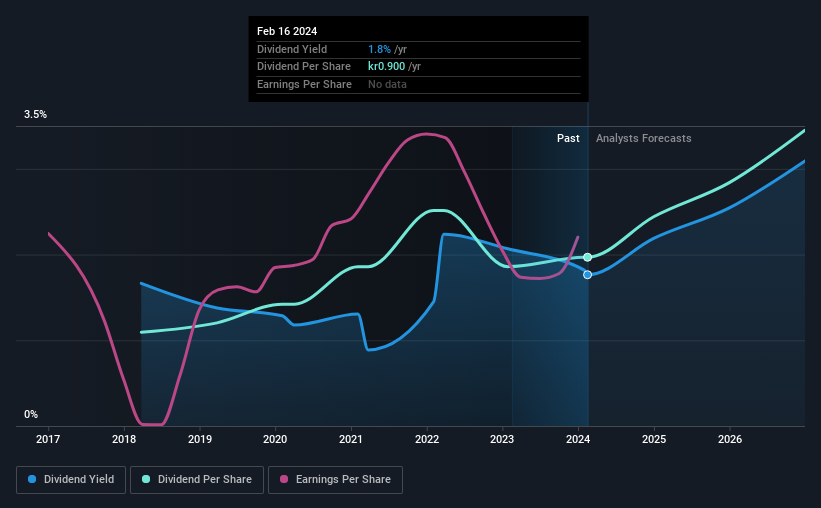Arjo AB (publ) (STO:ARJO B) has announced that it will be increasing its dividend from last year's comparable payment on the 25th of April to SEK0.90. Despite this raise, the dividend yield of 1.8% is only a modest boost to shareholder returns.
While the dividend yield is important for income investors, it is also important to consider any large share price moves, as this will generally outweigh any gains from distributions. Investors will be pleased to see that Arjo's stock price has increased by 37% in the last 3 months, which is good for shareholders and can also explain a decrease in the dividend yield.
View our latest analysis for Arjo
Arjo's Dividend Is Well Covered By Earnings
Even a low dividend yield can be attractive if it is sustained for years on end. The last dividend was quite easily covered by Arjo's earnings. This means that a large portion of its earnings are being retained to grow the business.
The next year is set to see EPS grow by 92.3%. Assuming the dividend continues along recent trends, we think the payout ratio could be 30% by next year, which is in a pretty sustainable range.

Arjo's Dividend Has Lacked Consistency
It's comforting to see that Arjo has been paying a dividend for a number of years now, however it has been cut at least once in that time. This suggests that the dividend might not be the most reliable. Since 2018, the dividend has gone from SEK0.50 total annually to SEK0.90. This implies that the company grew its distributions at a yearly rate of about 10% over that duration. Dividends have grown rapidly over this time, but with cuts in the past we are not certain that this stock will be a reliable source of income in the future.
The Dividend Looks Likely To Grow
Growing earnings per share could be a mitigating factor when considering the past fluctuations in the dividend. It's encouraging to see that Arjo has been growing its earnings per share at 10% a year over the past five years. Earnings are on the uptrend, and it is only paying a small portion of those earnings to shareholders.
Arjo Looks Like A Great Dividend Stock
In summary, it is always positive to see the dividend being increased, and we are particularly pleased with its overall sustainability. The company is easily earning enough to cover its dividend payments and it is great to see that these earnings are being translated into cash flow. Taking this all into consideration, this looks like it could be a good dividend opportunity.
It's important to note that companies having a consistent dividend policy will generate greater investor confidence than those having an erratic one. Still, investors need to consider a host of other factors, apart from dividend payments, when analysing a company. As an example, we've identified 2 warning signs for Arjo that you should be aware of before investing. Looking for more high-yielding dividend ideas? Try our collection of strong dividend payers.
New: Manage All Your Stock Portfolios in One Place
We've created the ultimate portfolio companion for stock investors, and it's free.
• Connect an unlimited number of Portfolios and see your total in one currency
• Be alerted to new Warning Signs or Risks via email or mobile
• Track the Fair Value of your stocks
Have feedback on this article? Concerned about the content? Get in touch with us directly. Alternatively, email editorial-team (at) simplywallst.com.
This article by Simply Wall St is general in nature. We provide commentary based on historical data and analyst forecasts only using an unbiased methodology and our articles are not intended to be financial advice. It does not constitute a recommendation to buy or sell any stock, and does not take account of your objectives, or your financial situation. We aim to bring you long-term focused analysis driven by fundamental data. Note that our analysis may not factor in the latest price-sensitive company announcements or qualitative material. Simply Wall St has no position in any stocks mentioned.
About OM:ARJO B
Arjo
Develops and sells medical devices and solutions for patients for clinical and financial outcomes for healthcare in Europe, Asia, Latin America, Africa, and Pacific.
Undervalued with excellent balance sheet.
Similar Companies
Market Insights
Community Narratives




